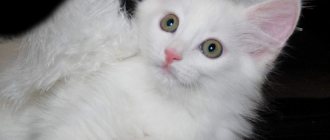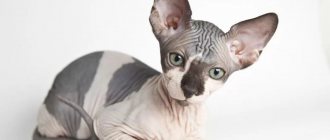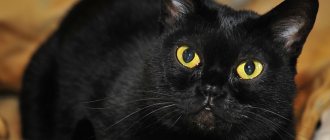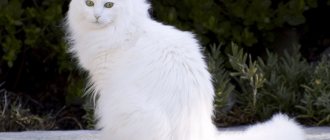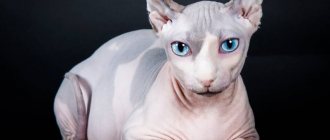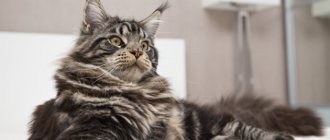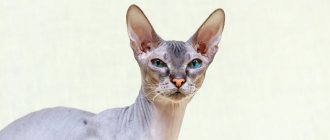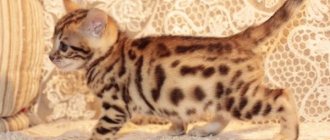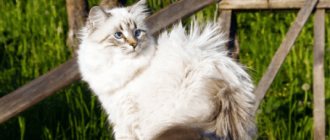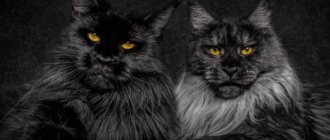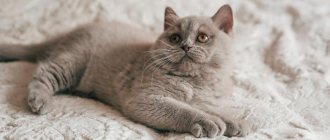- Pets
- >>
- Cat breeds
* Here is a photo of a typical representative of the Angora cat breed . You can send us photos of your animals by email, and we will post them on the website. Don't forget to send your pet's name.
Other breed names:
Turkish Angora
Video
* We invite you to watch a video about the Turkish Angora . In fact, in front of you is a playlist in which you can select and watch any of 20 videos about a given cat breed by simply clicking on the button in the upper right corner of the window. In addition, the material contains quite a lot of photos. By looking at them you can find out what a Turkish Angora looks like.
Rate the material!
[Total votes: 3 Average: 3]
With long, silky fur and a fluffy tail, slender paws and multi-colored eyes, the Turkish Angora is so beautiful that it seems as if it has just stepped out of the pages of a fairy tale book. Her beautiful appearance is perfectly matched by her royal stature and grace, as well as her dog's devotion to her master. Thanks to a considerable number of positive qualities, the Turkish Angora has earned enormous popularity among cat lovers.
History of the origin of Turkish Angoras
Turkish Angoras are incredibly beautiful, graceful and intelligent cats that long ago attracted the attention of the people of the Middle East and became their noble favorites. It is assumed that the ancestors of these cats were their wild Middle Eastern counterparts, which were especially numerous in the vicinity of modern Ankara in Turkey.
According to one legend, the Prophet Muhammad had a favorite cat, Mueza, with eyes of different colors, white fur and a fluffy tail. No animal had the right to enter the mosque, and only she was allowed to do so. It is believed that this cat was of the Angora breed.
Interesting fact: In Turkey, these cats were often given as gifts for significant family events (weddings, birth of an heir), as well as to ambassadors of other states as a sign of special respect. Angora cats have also been popular pets in the homes of rulers in the Middle East for centuries.
In Europe, the first representatives of this breed appeared during the Crusades, and with the beginning of active trade with the Ottoman Empire (16th century), cats were presented to European monarchs, who earned special favor from eastern rulers. It was the merchants who delivered them to Europe. Gradually, white fluffy Angora cats settled in almost all the royal courts of Europe. Turkish Angoras were brought to Russia a little later - during the Russian-Turkish wars.
The British fell in love with Angora cats, began to breed them, and already at the end of the 19th century began to present them at exhibitions. In the homeland of cats - in Turkey, unfortunately, no one was breeding cats for quite a long time, and their population gradually became very small. The situation changed radically in the 20s of the last century, when Angora cats began to be bred in one of the zoos in Ankara. Around the same time, these beautiful cats were given national treasure status, which prohibited their export from the country.
The ban was somewhat relaxed only 40 years later (in the 60s), but with one condition - obtaining special permission from the authorities to export the Angora cat. Few managed to obtain permission. Among them were the wives of two American diplomats, thanks to whom Turkish Angoras came to the United States, where no one was indifferent to their beauty.
Interesting facts about Angora cats
Angora cats are unique animals, interesting for their appearance, history of origin and habits. They never cease to amaze their owners throughout their lives.
At the same time, there are several interesting facts that few people know and which all lovers of this breed should know about.
Here are some of them:
- The Turks officially cemented their love for Angoras in 2015. It was at this time that the first coins with the image of this animal were issued in Turkey. Other countries also issued collectible coins with Angora cats. Such money is quite popular among collectors;
- Many animal lovers choose Angora cats because of their amazing eyes of different colors. Many people associate this demand with an ancient Turkish legend. According to it, the father of all Turks promised to give all his power to the person who was bitten by a white angora with multi-colored eyes;
- A distinctive feature of Angora cats is the ability to meow to themselves. Animals often “talk” with their mouths closed;
- All Angoras are very clean. They keep their snow-white fur in perfect condition under any circumstances. There is even a legend that Turkish rulers used these animals to wipe their hands on them after meals. The pets quickly washed off the dirt and regained their whiteness on their own;
- The Angora cat often acts as an actor. Thus, it was the representative of this breed who starred in the cartoon “Aristocrats” and the film “The Raven”.
Such pets will never make their owner bored and will always help him cope with a bad mood. Angora cats are good psychologists. Thanks to their excellent sense of smell, they quickly understand the condition of their owner. If he is sad, the pet will sit on his lap and purr. If the owner is in a good mood, the animal will support him with its playfulness.
Turkish Angora - description of the breed
The Turkish Angora is not a very big cat. However, it looks much larger than its actual size thanks to its long fur, slender limbs and long fluffy tail. According to breed standards, the height of the Turkish Angora at the withers is approximately 35 cm. At the same time, the male weighs no more than 5 kg, and the female weighs no more than 3 kg.
The cat's physique is fit, slender, elongated. A medium-sized head in the shape of a wedge or triangle is set on a graceful and sophisticated neck. The cat's eyes are quite large, slightly slanted, one might even say almond-shaped, like a real oriental beauty. The iris of the eyes comes in a variety of colors, and it is not uncommon for the same animal to have eyes of different colors. The ears are also large, set high, pointed and with small tufts at the tips.
The Turkish Angora's coat is long, very soft and silky, and has virtually no undercoat. It is most elongated in the neck, chest, hind legs, and between the toes. On the back of the cat there is a so-called cloak, consisting of long guard hairs. It is worth noting that all guard hairs have a hollow structure, which undoubtedly helps the animal feel quite comfortable in both hot and cool conditions. The color of the coat of these cats is quite varied, but the most valuable is the pure white color.
The tail of this cat is worthy of a separate description. In its length it can compete with the length of the entire body of a cat, and in appearance it resembles a peacock feather.
Popular colors of Turkish Angoras
In the homeland of Angora cats - in Turkey, as well as in Russia, Britain and the USA, it is generally accepted that the snow-white coat color is characteristic and original for this breed. In this case, the animal’s nose and paw pads should be pink.
Such an erroneous opinion arose for the simple reason that pure white Turkish Angoras are most common today. Probably, many will be extremely surprised, but these cats acquired white coat color not so long ago - in the middle of the last century, when it occurred to one of the breeders to bet on this color. Many people took up the idea and as a result, many pure white Angora cats appeared in the world.
Today, the Turkish Angora cat breed is characterized by the following shades of wool:
- Cream;
- Red;
- Light blue;
- Black or blue smoky;
- Marble, brindle, marbled, patchwork, silver, brown, blue, red, cream tabby;
- Chintz and light chintz;
- Tortoiseshell;
- Bluish cream;
- White black;
- White-red;
- White and blue;
- White-cream.
Such a variety of colors of Angora cats were first recognized not in their homeland, but in the USA. Without thinking twice, other countries followed this example, with Turkey almost last on the list.
Interesting fact: It is worth noting that over the past centuries the appearance of cats has not changed much, but, as already mentioned, bright white Angoras are the most common. At the same time, the most valuable are considered to be individuals whose ancestry comes specifically from Turkey.
On top of that, as a bonus, the Creator awarded the Turkish Angora with six, which never gets confused and practically does not shed.
Character and habits of Turkish Angoras
Angora cats are very smart, reserved, intelligent, wise, affectionate and active pets. At the same time, they are incredibly patient and accommodating, which allows them to get along well not only with adults and children, but even with dogs.
These are cats with an easy disposition: sociable, but at the same time unobtrusive. When they get into a family as a kitten, Turkish Angoras often choose one owner and obey only him. The devotion of these cats knows no bounds and is in some ways comparable to that of a dog.
These cats are never shy - they are always close to their owners. Even if guests come to the house, the Angora cat will not hide somewhere in a secluded corner, but will definitely come out to see who came there, get acquainted with everyone and show itself in all its glory.
Interesting fact: The intelligence of Angora cats is worthy of special attention. It allows animals to remember almost all of the owner’s movements: how cabinets, doors and even the refrigerator open in the house.
Tenacity is another characteristic trait of Turkish Angoras. If a cat wants to play, and the owner suddenly takes away a toy from her, she will trace where it was hidden and then she will definitely find this object, pull it out and continue playing with it. It is also common for these animals to remember the voices of their owners and distinguish among them the voices of their favorites.
These cats are also very playful, and at any age, even very old ones. Therefore, toys should always be available in the house. In games, animals love to demonstrate their extreme agility and jumping.
How much does a kitten cost?
The Angora breed, like the Anatolian, is widespread in Russia; there are more than enough nurseries where you can buy an Angora kitten both in our country and abroad. However, people who do not understand the breed standard should rely on the help of professionals.
The fact is that Angora cats cannot always be white, and not all white cats are Turkish Angoras; for example, Angora chinchilla, Turkish shorthair cat, Anatolian (Van) beauty can be sold under the guise of a desired kitten.
It is advisable to choose a pet from trusted nurseries with a good reputation, where there is no risk that instead of a purebred animal they will sell you a mixed breed or a kitten of a different breed.
The cost of Turkish Angora is low. The price depends on the cat’s pedigree, class, color and some other factors and starts from 5 thousand rubles. Elite class kittens with the purest pedigree will cost more - around 25 thousand rubles.
Video
Interesting facts about Turkish Angoras
Angora cats, like no other, are prone to heterochromia - different colors of the iris of the eye. The reason for this phenomenon is the increased or decreased content of melanin in the iris of the eye. Heterochromia is more common in animals (dogs, cats) than in people. Because of it, one eye may be blue, and the other green, yellow or brown.
Angora cats are often very talkative, and their manner of speech is quite unusual and somewhat specific. Of course, they also know how to meow, but they rarely do it. Most often, these cats purr inwardly without opening their mouths, and thus manage to convey the entire spectrum of emotions: from pleasure to irritation and anger.
Thanks to its excellent health, this breed is the longest-living cat, often living up to 20 years or more.
Turkish Angoras are true hunters to the core and the tip of their tail. Since ancient times, they have had a reputation as excellent mousecatchers. Also, thanks to their innate ability to jump, they can catch birds in flight and do this at any opportunity. Therefore, when keeping such cats in city apartments, where there is absolutely no opportunity to hunt, their owners must provide them with daily games. Rubber or plush balls, as well as imitations of rodents and birds, are suitable as toys.
These cats, more than their other counterparts, love to climb somewhere higher (on a table, on a cabinet) and from there watch what is happening below.
Angora cats are usually very obedient and intelligent. Therefore, if it is clear to them that something cannot be done, they will never violate the prohibition.
The Turkish Angora has many dog-like traits. For example, they quickly learn various tricks and commands: they bring a ball or other objects in their mouths to the owner, open doors and cabinets with their paws, turn on the light or TV.
Pros and cons of Turkish Angoras
The Angora cat has both its advantages and some disadvantages.
Advantages:
- High intelligence;
- A gentle and flexible character, which manifests itself in love for all family members and almost unquestioning obedience;
- Dog devotion;
- The ability to quickly adapt to any living conditions (apartment living, life in a private house);
- Playfulness and activity at any age;
- Love for affection and attention;
- Communication skills;
- Tolerance to other animals - cats and even dogs;
- Learning ability and ability to train;
- Disease resistance;
- Tendency to longevity. With an average life expectancy of 13-16 years, many cats live into their 20s;
- Love for walks. Moreover, unlike other breeds, leash training occurs quickly and without problems.
Flaws:
- Stubbornness and perseverance;
- Some obsession;
- Sense of ownership and constant need for attention;
- A large amount of wool during the molting period and not only;
- A genetic predisposition to deafness, which most often manifests itself in cats with white coat color;
- Rarity of the breed.
In the last couple of decades, the demand for this breed has fallen somewhat, as many cat owners complain about the difficulty in purchasing a purebred Turkish Angora due to the large prevalence of mixed breeds, even in nurseries. In this regard, it’s not even worth talking about private Turkish Angora breeders. Another reason for the drop in demand is the emergence of new breeds and increased interest in them.
Nutrition
Up to four months, kittens are fed four times a day with a 150 gram portion of food. Food should be balanced and rich in vitamins. Professional food is best. It's best to use several types.
Starting from four months, food intake is reduced to two times a day. It is necessary to follow the feeding regime. After a meal, cats often sleep. Those who want to feed their cat natural products should know that the food must contain 30% protein and 60% other nutrients.
The diet should contain the following products:
- beef, lamb, veal and poultry meat, but lean;
- quail eggs a couple of times a week;
- small quantities of dairy and fermented milk products;
- boiled vegetables.
Breeding Turkish Angoras
Those who are planning to seriously engage in breeding a cat breed such as the Turkish Angora should know that mating two individuals with white hair is extremely undesirable, since the future offspring have a serious risk of developing deafness. Among breeders in Western European countries there is even an unspoken ban on this. This measure made it possible to significantly reduce the number of births of kittens with deafness.
Although there are many nurseries engaged in breeding Angora cats, as recent experience shows, it is quite difficult to find a purebred partner with a “pure” pedigree for mating. It is very desirable that the cat already has experience, that is, he is untied. Need I say that a cat intended for breeding also has an impeccable pedigree? In addition to checking the pedigree of both mating partners, it is also important to have them examined by a veterinarian.
Usually a separate room is allocated for mating. In this case, it is very advisable to leave the animals alone. The mating process with all foreplay can last from two to five days.
Puberty in a Turkish Angora cat occurs at approximately one year of age or a little earlier. Purely hypothetically, mating can be carried out already at this age. Experienced breeders have a different opinion on this matter. They advise skipping a few cycles on the cat, and only then taking her to breeding. The optimal characteristics for starting breeding in an Angora cat are age 1-1.5 years, weight - 3 kg, as well as good physical shape and absence of diseases. At the same time, the recommended frequency of births for a cat is twice every three years. This allows the animal’s body to fully recover in order to again produce strong and healthy offspring.
The gestation period for an Angora cat is approximately 9 weeks. The female can give birth on her own for up to 10 years. After this age, it is better not to mate, as there is a risk of giving birth to a weakened or sick offspring.
During pregnancy, the cat's owner needs to closely monitor the cat's health. If any alarming symptoms appear, it is better not to self-medicate, but to consult a veterinarian. The first birth of a Turkish Angora can last 2-6 hours. Young, inexperienced cats often meow during childbirth, thus calling on the owner to help.
If labor is weakened, labor may drag on for a day. In this case, it is better to take the cat to a clinic where it can receive professional help. After birth, the offspring and the woman in labor are moved to a spacious box with clean bedding.
Breeding Angora cats
Intentional breeding of Angora cats began only in the 20s of the 20th century. Such measures were necessary in order to prevent the breed from becoming extinct. For 40 years, Turkish felinologists fought to preserve this individual and actively bred white fluffy cats. All this time, a strict ban was imposed on the export of these animals.
Interesting fact: To cross the border with an Angora cat, it was necessary to obtain special permission. It was also issued to two women who were wives of US military officials. It was they who managed to take the unique breed overseas, where the breeding of the Angora cat began, not to preserve the population, but to spread the breed throughout the world. This happened in the 60s of the last century.
Already 10 years after the start of Angora breeding (in 1973), these animals were identified by felinologists as a separate breed. In 1979, the Angora cat was recognized by the International Cat Association, and 15 years later, European felinologists officially expanded the number of shades allowed for this breed.
Today, Angora breeding is carried out by both professional felinologists (breeders) and amateurs (breeders/breeders). The former are distinguished by a more serious approach to this activity. They breed only breeding animals, carefully selecting partners based on numerous criteria (character, color, pedigree). Breeders sell animals directly from shelters, where the buyer can evaluate the living conditions of the pet, its characteristics and features of the appearance and behavior of the parents.
Breeders approach breeding Angoras from the material side. For them, what is more important is not the purity of the breed, but the fastest possible profit. As a rule, breeders sell the offspring of their pets “from hand” through message boards and social networks.
If you want to buy a breeding cat, be prepared to pay a lot of money. Such animals cannot be cheap, since entire associations are involved in the development of their population. A distinctive feature of breeding Angoras is the presence of Turkish roots in the pedigree.
Caring for Turkish Angoras
Like other pets, Angora cats require regular grooming, which includes bathing, eye and ear care, brushing, and nail trimming.
It is worth noting that it is not at all necessary to bathe a Turkish Angora, if it does not go outside at all, since the animal copes well with its hygiene on its own, licking its fur daily. If the animal is a show animal, then bathing is one of the stages of its preparation for the upcoming demonstration. It is clear that you only need to bathe your cat with a special shampoo, while being careful not to wet its head and ears. In general, too frequent water treatments are contraindicated for cats, since bathing washes off the protective fat layer from the skin.
The eyes of Angora cats need to be cleaned a couple of times a week. Cotton swabs soaked in chamomile decoction or weakly brewed black tea work well for this. In this case, a separate swab is used for each eye. If, during care, signs of infection suddenly appear (redness, pus), then the pet should be shown to a veterinarian.
Important fact: Pets' ears are also examined approximately once a week for redness and rashes and wiped with damp hypoallergenic or baby wipes.
Trimming a cat's claws is not a mandatory procedure, since you can purchase a special device for grinding down the claws - a scratching post. If the animal tends to scratch or damage furniture, then it is better to trim its claws. This should be done approximately once every two weeks using special scissors or nippers, which can be purchased at a pet store.
Care
The luxurious fur of Angora cats requires constant care. She needs to be brushed at least 3-4 times a week, and during shedding it is better to do this every day. Using a special brush, they first go over the head and back, carefully comb the tail, then move on to the belly and paws. Particular attention should be paid to the fluffy “whiskers” and “pants” and especially the thin, delicate fur behind the ears: without careful care, the hair in these places rolls into ugly tangles, which greatly spoil the appearance of the animal. It is impossible to comb such a tangle; you just have to cut it off. Angora cats favor water procedures. They are bathed once or twice a month, with white coat color - more often than others. Buy shampoos only those intended for cat hair. Human hygiene products cannot be used. Be sure to check the condition of your teeth daily; if tartar appears, contact veterinary clinics for timely removal. Discharge from the eyes is especially noticeable against the background of white fur. They must be carefully removed with a cotton swab moistened with warm boiled water. Ear care comes down to regular inspection and treatment. Using a cotton swab soaked in liquid petroleum jelly, carefully treat the ears, after which hydrogen peroxide can be applied. Some cats are tolerant of this procedure. But most show violent resistance and can severely scratch the owner. In this case, it will be convenient to wrap the cat in a towel and clean the ears as quickly as possible. Overgrown claws are periodically trimmed with special tweezers, otherwise your pet will do the manicure herself, sharpening her claws on chairs or door frames.
Diet of Turkish Angoras
Angora cats often have sensitive digestion, so their nutrition requires special attention.
As for your pet's diet, it should be nutritious and carefully balanced. If you want to feed your cat natural products, it is advisable to contact a professional who will help you create the right menu taking into account all the needs of the cat’s body. At the same time, a third of the Turkish Angora’s diet should be proteins.
The most beneficial protein foods for cats are:
- Chicken;
- Turkey;
- Sea fish.
The menu should also include grains (rice, oats, buckwheat), vegetables (carrots, pumpkin, cauliflower), milk (yogurt, kefir, cottage cheese), eggs (chicken, quail).
It is extremely undesirable to feed cats of this breed monotonously, as well as with leftover food from the owner’s table. After all, this method of feeding guarantees indigestion and various allergic reactions. After all, human food for cats is too salty, spicy and fatty, plus it contains a bunch of harmful additives.
Important: if a cat has a bright white coat, then in order to keep it that way, it is advisable to exclude some by-products (liver, kidneys, heart) and seaweed from the menu. If the owner prefers to feed the cat with specialized food, then it is best to give preference to premium dry or wet food.
With any method of feeding, and especially with dry food, it is very important to provide the animal with constant access to water. In this case, the water must be clean and fresh. In addition, unlike other cat breeds, Angoras love to drink, and do so quite often. It is also necessary to offer the animal special grass. You can grow it yourself or buy it ready-made at a pet store. The grass is necessary for the animal to cleanse the intestines of hair.
When feeding cats, it is also important to consider their age and physical condition. For example, kittens and pregnant women need to be fed more often - 3-4 times a day; adult cats need to be fed twice a day. In addition, sick and elderly cats require a special diet.
Health
The Turkish Angora is characterized by good health; this breed does not have any specific diseases. However, in order for your pet to live to old age, you need to take care of it: regularly show it to the veterinarian and vaccinate it. The cat needs proper care.
The following factors can undermine the health of a pet:
- incorrectly selected diet;
- lack of sufficient movement;
- contacts with carriers of infections;
- excess weight.
Cats of this breed need to exercise a lot, otherwise it may develop problems with the musculoskeletal system. Excessive weight can cause heart disease. After 10 years, cats may develop tumor processes.
Vaccinations are given like everyone else: the first at two months, then according to the schedule. Vaccination will protect your pet from dangerous viral infections. You should also treat your cat against ticks, fleas, and lice with special compounds.
This is especially necessary for cats that walk outside or live in a country house.
Classic-looking Angora cats, like all white cats, often suffer from deafness. If the eyes are the same, blue, then the cat will be deaf with a 40% probability. If the individual has different eyes, then one of the ears remains hearing.
When mixing a snow-white Angora with a colored representative of the breed, the risk of deafness in the offspring is reduced.
Diseases and health problems
In general, Angora cats are in excellent health and do not get sick very often, thanks to their innate strong immunity.
A couple of decades ago, cats with deafness were often encountered due to acquired genetic mutations. Moreover, the appearance of deafness was typical only for blue-eyed individuals with white fur. Thanks to selective selection and the ban on mating two white Angora cats, the risk of this pathology has been significantly reduced. In Western European countries, currently all purebred cats with white fur are necessarily checked for deafness using a special test.
In addition to deafness, the Turkish Angora suffers from two more serious diseases: ataxia and hypertrophic cardiomyopathy. Hypertrophic cardiomyopathy is caused by hypertrophy of the heart muscle.
Which is manifested by the following symptoms:
- Cough;
- Dyspnea;
- Fatigue during exercise.
If the disease is diagnosed in time, it can be quickly and successfully treated. A disease such as ataxia occurs only in Angora cats. Its symptoms manifest itself in a sharp loss of coordination of movements, after which the animal completely stops moving and dies. Unfortunately, today this disease has no cure yet.
In addition to a few diseases, Turkish Angoras may have some defects in appearance that do not allow them to participate in exhibitions. These include being too large in size, having a head that is too round, short limbs, a somewhat squat build, and a knobby or insufficiently long tail.
Breed cost
The Angora breed is quite common; finding a kitten will not be difficult. To purchase a baby that fully meets the standards, you should pay attention to the reputation of the club through which you plan to purchase. Choosing a kitten from a private advertisement or on the market is a risky path. It is better to contact the club, there is information about breeders whose cats have offspring.
You can also buy a kitten directly at the exhibition. How much a Turkish Angora costs depends on its pedigree, color, health and age. The cost of kittens with good pedigree and exterior starts from 30 thousand rubles .
When purchasing, you should carefully check all documents from the birth certificate to the vaccination card or veterinary passport. Kittens without a pedigree from an unscheduled mating are sold for 5–10 thousand rubles .
As a rule, kittens are sold at the age of 3–4 months, they are already quite independent, and weaning from their mother occurs painlessly. Kittens older than this age get used to new surroundings and people in a more difficult way; at this age they have already formed the necessary behavioral habits. Therefore, such animals are often cheaper than three-month-old ones. The most expensive are white individuals with blue eyes or heterochromia.
How to choose a kitten
Angora kittens are active, playful and curious. There are usually 4 kittens in a litter. By 12–16 weeks, they are already sufficiently trained in basic skills, socialized, able to easily endure separation from their mother, and adapt to new circumstances. When purchasing kittens, you need to take into account that due to their activity and curiosity, they are able to climb into the most unexpected, hard-to-reach places and crevices, risking falling or getting stuck.
Unlike adult animals, 3-4 month old kittens look clumsy and fat and bear little resemblance to graceful creatures. Signs of the constitution inherent in adult animals begin to appear by 5 months.
